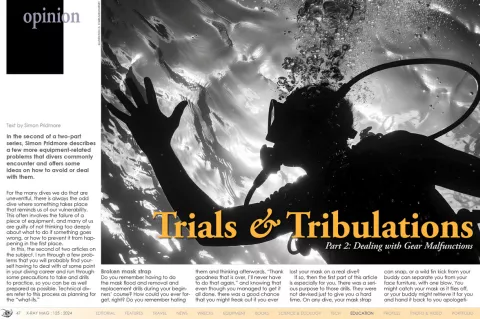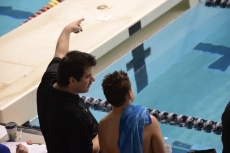In the second of a two-part series, Simon Pridmore describes a few more equipment-related problems that divers commonly encounter and offers some ideas on how to avoid or deal with them.
Contributed by
For the many dives we do that are uneventful, there is always the odd dive where something takes place that reminds us of our vulnerability. This often involves the failure of a piece of equipment, and many of us are guilty of not thinking too deeply about what to do if something goes wrong, or how to prevent it from happening in the first place.
In this, the second of two articles on the subject, I run through a few problems that you will probably find yourself having to deal with at some point in your diving career and run through some precautions to take and drills to practice, so you can be as well prepared as possible. Technical divers refer to this process as planning for the “what-ifs.”
Broken mask strap
Do you remember having to do the mask flood and removal and replacement drills during your beginners’ course? How could you ever forget, right? Do you remember hating them and thinking afterwards, “Thank goodness that is over, I’ll never have to do that again,” and knowing that even though you managed to get it all done, there was a good chance that you might freak out if you ever lost your mask on a real dive?
If so, then the first part of this article is especially for you. There was a serious purpose to those drills. They were not devised just to give you a hard time. On any dive, your mask strap can snap, or a wild fin kick from your buddy can separate you from your face furniture, with one blow. You might catch your mask as it flies off, or your buddy might retrieve it for you and hand it back to you apologetically. But there is no guarantee that this will happen.
Losing your mask is not a serious problem, in itself. You will be visually impaired, but you can still tell up from down. Just gather your thoughts and make a slow, careful ascent to the surface, breathing from your regulator as normal and remembering not to inhale through your nose.
However, losing control of yourself and panicking when you lose your mask, and bolting to the surface when it happens, could cause you major harm. So, you need to be certain you will not panic. And there is only one way to make sure of it.
In a pool or shallow water, remove your mask at the surface, then descend and swim along for a few minutes, staying calm and breathing through the regulator, before ascending again. Squeeze your nose closed with your fingers on the first few attempts if you must. While you are underwater, look at how you can still see the larger numbers on your dive computer and pressure gauge. Notice how the design of your regulator’s second stage diverts the bubbles away from your nose and eyes.
Everyone can do this. It just takes practice, then more practice. The confidence boost that mastering this skill gives you, especially if you previously thought it was impossible, is enormous.
Loose or lost weight-belt
It is important that your weight belt does not fall off during a dive. Hold on to it at the buckle when you enter the water and check that the buckle is still tight and that the belt is correctly positioned around your waist, before descending.
OK, so most people do this anyway. However, as you descend, the increasing water pressure at depth will compress the neoprene in your wetsuit and your weight belt will become looser. So, remember to reach down and tighten your weight belt a little once you arrive at depth. Of course, once you have done this, you may find that the belt becomes tight when you return to the shallows. If so, just relax the buckle again.
There is also the chance of a runaway ascent if your weight belt comes off. To minimise the danger that this presents, do the following three things.
1. Buy a BCD with little integral buoyancy—that is, a BCD that will give you sufficient buoyancy on the surface when you inflate it, but when deflated, does not require a large amount of extra weight to get it underwater with you.
2. Practice releasing the air from your BCD quickly. Know where the dumps are and the best body position to adopt to make sure no air is trapped inside.
3. Do a check to make sure you are not diving overweighted. At the end of a dive, at 5m, with 50 bar in your cylinder, empty your BCD and hold your breath briefly. If you sink, you have too much weight.
BCD failure
BCDs are highly reliable, but they can fail in a couple of ways that you may not have considered.
It is a great advantage to be able to add air to the BCD directly from the cylinder via the low-pressure inflator hose, but the valve at the BCD end of this hose can corrode and fail, allowing air to seep into the BCD automatically. A sign that this is happening is if you find yourself constantly having to dump air when you have not added any.
Keep the valve corrosion-free by wiping it clean with a little white vinegar on a cotton bud. If the valve is already corroded, it may be too late for vinegar. Ask a dive centre to replace it with a new one.
If you are using rented equipment, and the valve is auto-inflating your BCD, then the solution is to disconnect the hose underwater, dump the air and then inflate the BCD orally whenever you need to and after you get to the surface. This is another good skill to practise.
Shocking as it may be to contemplate, you also need to be prepared for your BCD to stop functioning as a flotation device. BCDs are made of tough material that is hard to pierce, but the fabric can become worn and fragile with frequent exposure to the sea and sun.
The real potential failure points in a BCD, however, are the dump valves, which are made of plastic that can develop cracks over time and with the sort of rough treatment that scuba diving gear usually gets. The cracks are often difficult to see, and the first sign of a problem is usually bubbles escaping from the fitting. But sometimes there is no warning. I have seen an apparently perfect shoulder dump valve shear off completely when the BCD was inflated underwater.
If this happens, your BCD immediately becomes useless as a buoyancy device and the dive is over. Swim to the surface, dumping some weight along the way if you need to, and once you are at the surface, dump all your weight to stay buoyant.
Rolling into the deep without air
When you start diving, you think that it will never be possible for you to start a dive without a functioning air supply.
One thing I will always do,” you promise yourself, “is make sure I have air to breathe, and everything is working perfectly before I go into the water.”
Then, one day, it happens.
You drop into the water with your cylinder valve closed. Every diver has done this. If you have been diving for a while, you will have experienced this at least once. Without going into the many reasons why, here is how to make sure it never happens to you again.
As you will notice, there are several checks and balances in this process, but it quickly becomes instinctive.
1. When assembling your gear, turn the cylinder valve all the way open, as far as it will go.
2. Put your gear on and, still on the beach or the boat, put the regulator in your mouth and take at least four full breaths. Why four? Because if your valve has somehow been closed again since you opened it, it will take you four breaths to clear all the air in your regulator hoses, and you will get a horrible empty, sucking sensation on the back of the fourth breath. It is better to encounter this on the beach or boat than when you are underwater.
3. Watch your pressure gauge as you breathe. The needle should not move. If it moves, your valve is shut or not completely open.
4. If the regulator does not breathe easily and/or the pressure gauge needle is moving, reach behind you and open your valve fully.
5. Don’t let anyone else touch the cylinder valve after that. If anyone does touch your valve, then go through steps 2, 3 and 4 again before you go into the water.
6. Sometimes, dive conditions require that you enter the water negatively buoyant and descend immediately. If this is not the case, always go in positively buoyant with your regulator in your mouth and take a few more breaths on the surface before you go down.
7. Finally, if, despite all of the above, you ever find yourself with a vacuum in your regulator as you descend, you must know how to open your cylinder valve underwater. The usual technique is to reach down and behind you with your left hand and push the base of your cylinder upwards. Then reach behind your neck with your right hand, grasp the valve firmly and turn it away from you.
Again, practice, practice, practice—until you can do it perfectly. ■
Read Part I of this series at: xray-mag.com/content/trials-tribulations-part-i.



























